
Can “pop”-ness be quantified? Is there a quality, inherent in the shiniest, rubberiest, squeakiest, squeeziest expressions of disposable culture, that can be distilled into pure essence of pop? If so, what is it? A product’s giddy embrace of its instant obsolescence? An earnest attempt at mass appeal that stumbles unwittingly into kitsch or camp or brain-scalding weirdness? An unselfconscious delight in its wiles, counterweighted by a slyly self-mocking awareness of just how unconvincing its seductions are? All of the above? Where’s Andy Warhol when we need him to Explain It All For Us with one of his brilliantly vapid aphorisms?
Kaiju toys, which I recently discovered while researching “Scary Cute,” my November 2005 I.D. magazine article about Japanese designer toys, are the coagulated essence of Japanese pop culture. Manufactured by companies such as Bandai and Toho, these collectible vinyl figurines are based on characters from the Japanese monster movies whose heyday was the late ’50s and ’60s, when tyrant lizards with conspicuous zippers ruled the earth (or, at least, the onscreen dream life of a nation trying to exorcize the post-traumatic specters of Hiroshima and Nagasaki). As well, they draw on Japanese ghost stories and folktales.
Now, a feverish, mostly adult U.S. fandom is paying astronomical prices for these toys, bidding them into the stratosphere on eBay or buying them from retailers such as Toy Tokyo and Giant Robot.
I don’t delve very deeply into the kaiju subset of vinyl-toy fetishism in my sprawling I.D. article, whose keyhole view of the vinyl toy subculture focuses on Western artists’ inspired glosses of Japanese toys, many of which were, in turn, loving knockoffs of Western pop-culture icons such as G.I. Joe, Playmobil figurines, ’70s cereal-box characters, and Big Daddy Roth’s hot-rodding Rat Fink.
A Herculean effort, the article damn near killed me. I interviewed a cast of thousands, including Frank Kozik, Tim Biskup of Gama-Go fame, Nathan “World of Pain” Jurevicius, Pete Fowler (known for his Monsterism toys), and Japanese designers such as Devilrobots, Touma, Mori Chack, and Junko Mizuno.
Here’s a teaser:

Japanese designer-toy artists continue to draw inspiration from the clash between Japan’s Blade Runner present and its venerable traditions, producing work that marries traditional values such as the delicate balance of opposites (as in the kowaii/kawaii, or “creepy/cute,” aesthetic) to a postmodern love of ironic (yet affectionate) quotation. Some, such as Touma, Mori Chack, and Junko Mizuno, take the cuddly-sinister aesthetic to new extremes, adding the frisson of punk-rock aggro. A Japop synthesis of kiddie culture, irradiated deformity, and simmering hostility, their work mocks the suffocating cuteness of much Japanese commercial culture. Touma’s scowling, growling KnuckleBears cross Winnie-the-Pooh with the Terminator. Mori Chack’s Gloomy Bear is warm and fuzzy yet red in tooth and claw, accidentally bear-hugging its child owners to death (or so goes the “character explanation” on the packaging). Junko Mizuno’s Miznotic Fantasy dolls reincarnate in PVC the moist-eyed waifs in her ero-guru (“erotic-grotesque”) manga–baby-faced women who gnaw on bloody bones or gambol naked with decomposing cadavers, exorcizing the petite, sweet-faced Mizuno’s frustration at being treated like a doll.
My valentine to the rubbery seductions of kaiju figurines will have to wait for another day. In the meantime, here’s a gallery of these weird little totems, whose overripe colors and glossy vinyl skins are so luscious–so visually tactile–that you want to caress them, maybe even consume them, with your gaze.
A feast for the eyes…



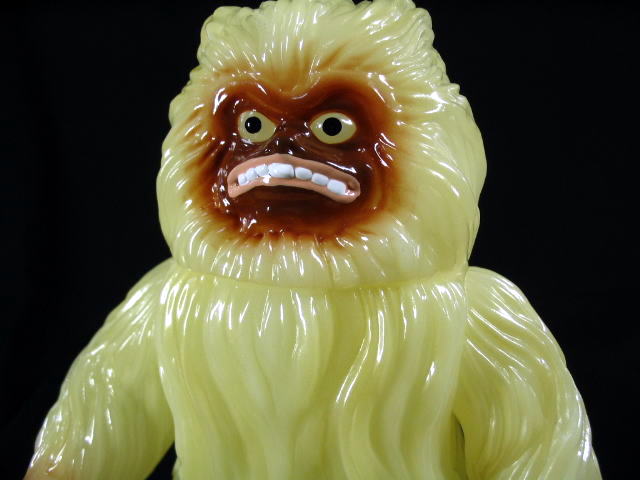


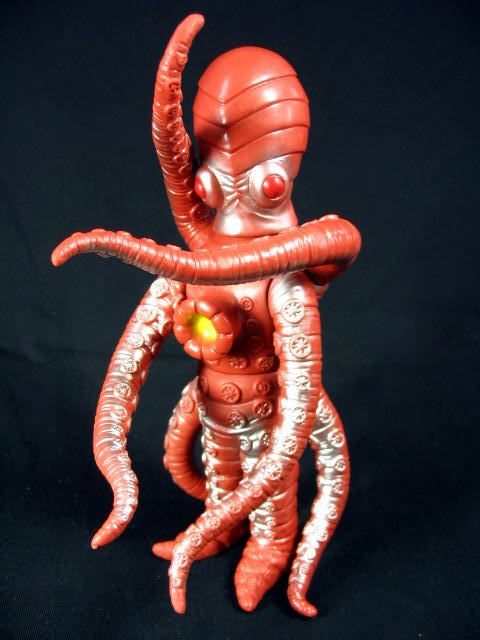
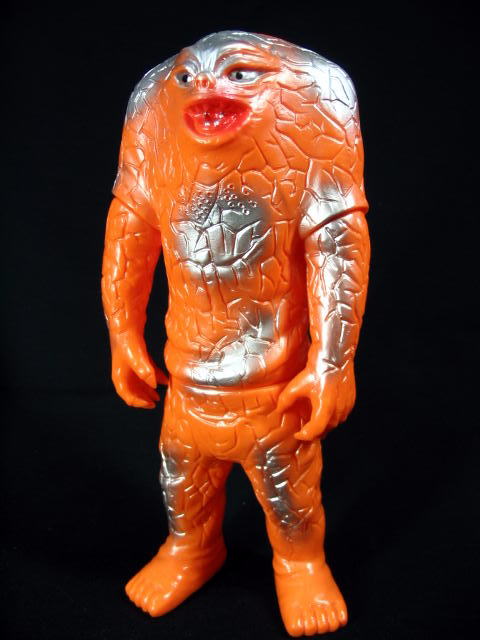
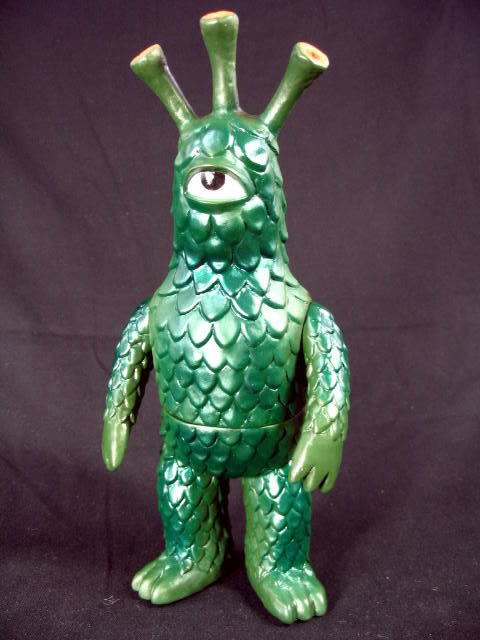

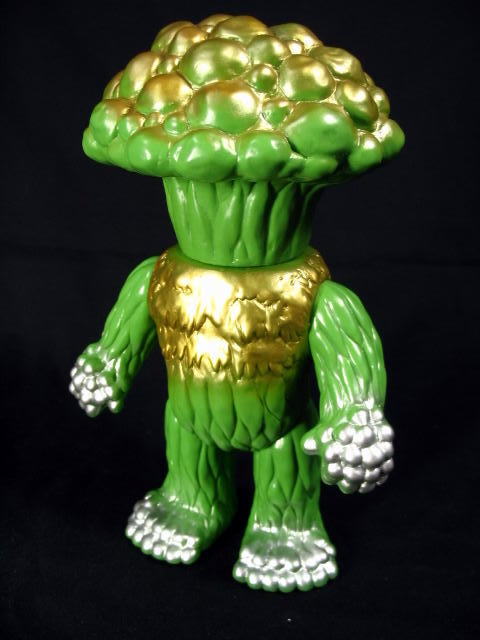
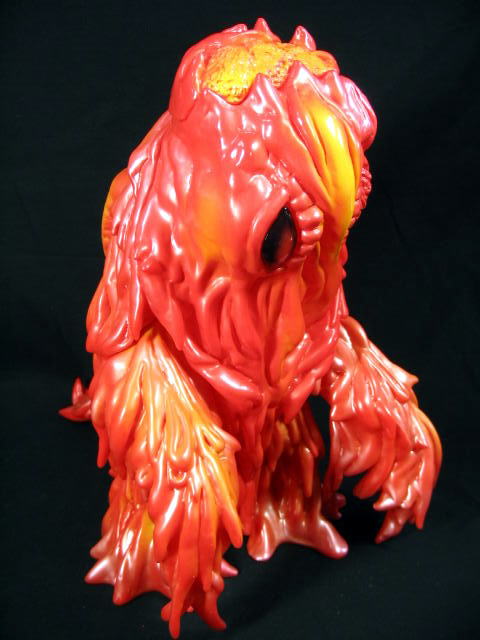


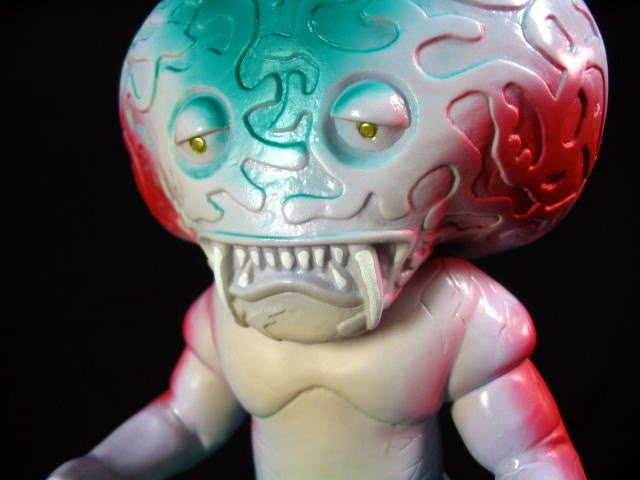

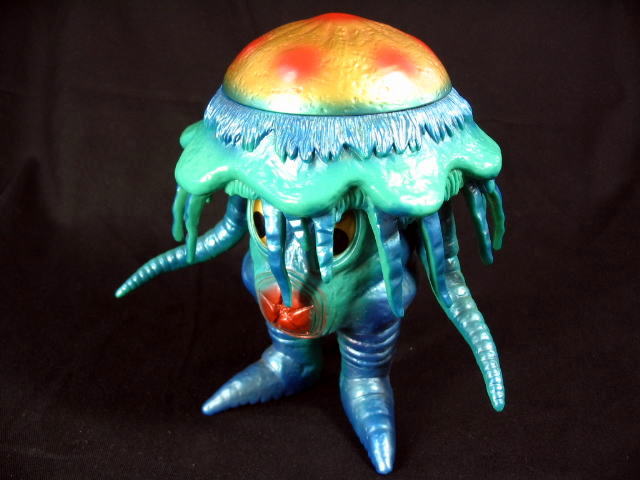
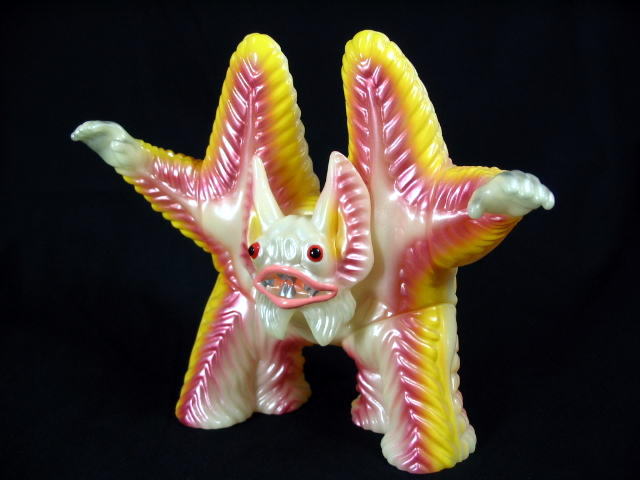
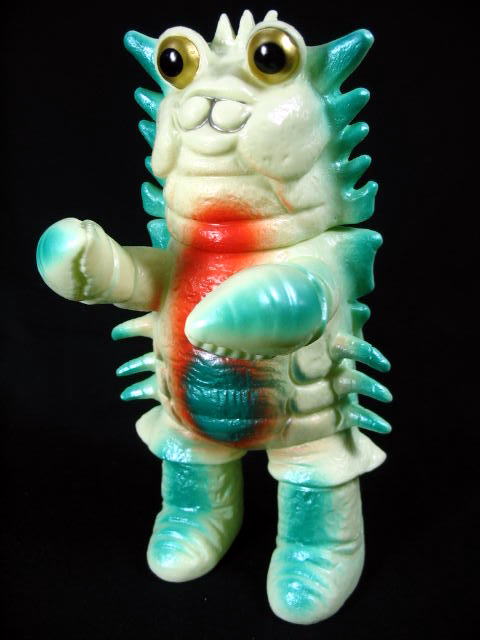
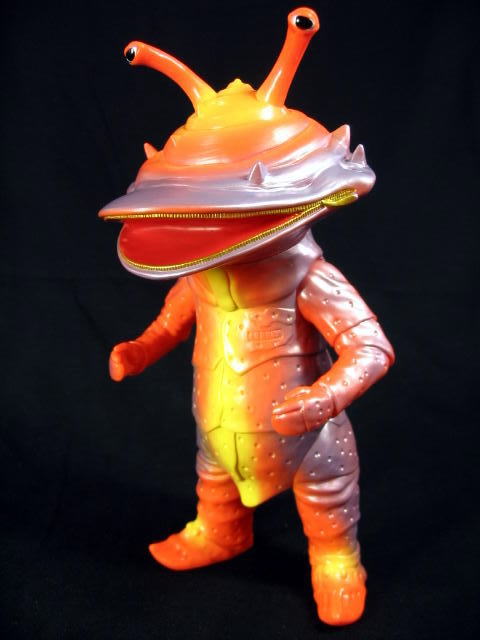
Moon
First let me welcome you, for i was worried I’ll never read your interesting thought ever again!
second, I’ll take my time to read and o\ponder carefully over the topic, you presented…I’ll be back :)
hilaricus
it is just the pathetic way of the so called artist , to make a doll of their images, not to visualise it , naah , to market the trash , see the big boys , front page shows the dolls , the gallery is in second place, every artist with a doll is not to be taken seriously by me.
commercial BS if you ask me , which you did not, but then again I am dutch and dutchies never stop complaining and whinin and are always very irritating because of their long comments on blogs,
Have a nice day ,
hilaricus
and the moldmaking limits the design , so do the colors of the granulate, that’s why most puppets are roundfaced, the ones you show are not but then again that is soft plastic , not for kiddysale , cheap chinese production.
M. Dery
But who am I to be critical?
big ghost
A feast for the eyes indeed. Strange radiating Japanese beasts, scary people.
. . . . . . Great books too amigo, I always follow your work with interest. Thank you Mark. Stay up on that cow!
Animal salutations.
Steve
Keep blogging. You’re my favorite brain fertilizer.
-s.
M. Dery
That’s why they call it blogorrhea. But thanks. I hereby swear a blood oath to blog at least biannually, in my pathetic bid for Jeff Jarvis-ian Mastery of the Bloviosphere. My fan deserves nothing less.
m
a few of those fellows look familiar, though it’s been so long since i’ve taken in a classic Toho flick I no longer know Megalon from Mechagodzilla. I’m surprised that you neglected to bring attention to the strikingly Freudian mugs on kaiju toys #12 and #16 down from the top! Maybe that’s an entirely different can of cross-cultural worms…
M. Dery
Actually, most of these kaiju wouldn’t be caught dead with Megalon or Mechagodzilla. Some are from Ultra Man, others are from the bizarre genre of folktale-inspired Japanese horror movies, perhaps best exemplified by Yokai Monsters: 100 Monsters (http://www.amazon.com/gp/product/B000093NPD/ref=pd_sxp_f/103-4680000-4076649?s=dvd&v=glance&n=130) and Matango: Attack of the Mushroom People (http://www.amazon.com/gp/product/B00076ON28/ref=pd_sbs_v_2/103-4680000-4076649?%5Fencoding=UTF8&v=glance&n=130).
Stefan Jones
Some of Jim Woodring’s nightmare creatures — Newts and other Unifactor oddities — have been turned into Japanese toys.
I think the Japanese may be the first nation to hit the Singularity, and seeing how thoroughly creepy it turns out may convince big chunks of the rest of the world to go Amish.
fústar
The old “monster spawned by radiation” sub-genre of sci-fi/horror/fantasy is indeed a curious one. It’s remarkable to think that ‘Gojira’ first put in an appearance a mere 9 years after the flattening of Hiroshima and Nagasaki, and an even ‘merer’ few months after the Castle Bravo/5th Lucky Dragon incident.
Given the atmosphere at the time, and the strong anti-nuclear sentiment in Japan, there was nothing funny about this particular ‘guy in a rubber suit’. Later Toho offerings may have descended (or ascended) into the absurd, the daft, and the amusing…but the original ‘Big G’ still retains a terrifying sense of immediacy and imminent horror.
Oh and great to (belatedly) discover this here blog. “The Pyrotechnic Insanitarium” is a great favourite of mine Mark, and it always ‘recharges the batteries’ whenever I dip into it.
moon
while reports say that robots keeps a human “look”
and this is what the public wants…the pop culture of dalls keeps getting creepy and scary and bizzar!
how can one explain this paradox?
M. Dery
Stefan: Fascinating way of putting it. Is that Vernor Vinge’s singularity, I wonder? The strangest thing about Japanese pop culture, in my limited, precession-of-the-simulacra 15th-generation experience of it, is that some of the weirdest stuff turns out to be mutated strains of American culture. As in: http://www.btinternet.com/~nsinbath/bxh.htm.
Fústar: Thanks for the props. Nosed around your site and was no less impressed. Have you seen the ghost-and-goblin-inspired “yayoi” movies I mentioned above? Weird beyond description, and ineffably *Japanese*, somehow.
fústar
Thanks for the kind words Mark. Had heard of the “Matango: Attack of the Mushroom People” because of the Ishiro Honda connection, but had no idea it was available on DVD (albeit only in the US). It sounds deeply bonkers and undeniably intriguing. One to dust the credit card off for…
“Yokai Monsters – 100 Monsters” was a new one on me, and (after doing a bit of digging around) have just seen it described as “One part horror film and one part Teletubbies”. Sounds great…in a deeply disturbing, wildly fun, ‘stuff of nightmares’ kind of way. “Scary Cute” indeed…
Stefan Jones
“Is that Vernor Vinge’s singularity, I wonder?”
[Paragraph]
I think there are two basic types of techno-social singularity.
[Paragraph]
One is Vinge’s . . . technorapture of the nerds, beloved by wanna-be transhumans. The end of things as we know it, brought about by asymptotically evolving A.I.s
[Paragraph]
The other is a less drastic thing, envisioned as long ago as 1966 (“Day Million,” Frederick Pohl). Put simply: Past a certain point, technologically – spawned cultural change makes life in the future effectively indescribable.
[Paragraph]
Warren Ellis pictures this nicely in one of his Spider Jerusalem stories. Revived “corpsicles” are so culture-shocked that they cower in alleys in the daylight hours in which they’re tossed out of their bleak Revived hostels.
fústar
Possibly going off on a tangent here Stefan, but your mention of transhumanism reminds me that I’ve been a bit negligent (of late) in keeping tabs on the Extropy Institute and its ilk.
Back in the late 90s it seemed that the whole nanotechnology-lovin’ / Hans Moravec-esque / transhumanist / “Up with Technology!” / dream was very much in ‘its moment’. I wonder where it is now…in zeitgeist-y terms…?
Are levels of gee-whizz hubris still as high as ever?
Stefan Jones
“Are levels of gee-whizz hubris still as high as ever?”
Well, you always have that core of true believers. (Heck, there are still folks out there pushing asteroid mining and L-5 colonies.)
But I suspect there are more folks worried about how they’ll make due after Peak Oil than those planning on getting their brains diced up and uploaded so they can tour the galaxy embodied as starships.
Me, after Bush was reelected I invested in fast food, casinos, and liquor, because no matter what tomorrow brings greed, gluttony, and delusion aren’t going out of fashion.
free
and or http://sraka.myip.us/2/33.html free or http://sraka.myip.us/2/4.html and …. free free http://sraka.myip.us/2/23.html html and http://sraka.myip.us/2/24.html no no http://sraka.myip.us/2/22.html .Thanks.
Stefan Jones
Will there come a day when SPAM is so cute that you don’t want to delete it?
You know, like little virtual kittens that play on your screen unrolling yarn to spell FREE HOT HOT LOWLEETA AXION, and that when you try to erase them howl and look at you with big sad eyes?
M. Dery
These are the generations of Spam: And Adipex begat Phentermine, and phentermine begat credit reports, and credit reports begat online poker bonus, and online poker bonus begat Texas hold’em…
Just for you, Stefan, I’m letting that hunk of spam rot there, in perpetuity.
M. Dery
And that, appropriately enough, is the last word on this subject. Comments closed.